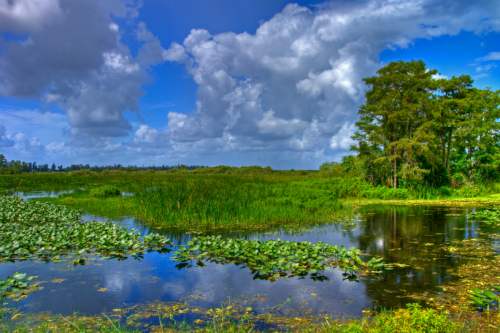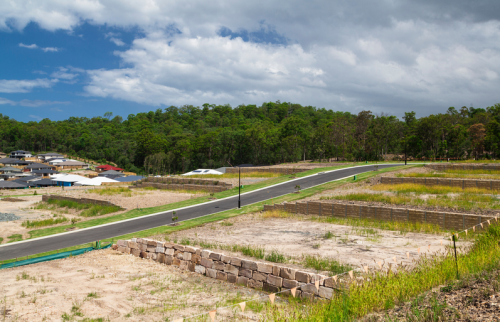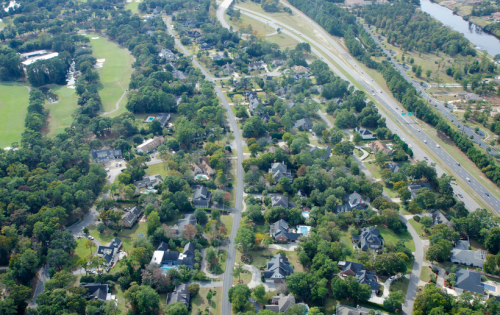More than 1,000 people move into Florida every single day. As people pour into the state, policymakers must plan how to balance this growth with the health of the state’s natural resources and landscapes.
For this session, there are several bills on the table regarding the designation of wild areas, creating funding for conservation projects, and adding tweaks to current Florida land development laws.
Here’s what it’s all about:
- Land Acquisition Trust Fund
- Land Development Initiative and Referendum Processes
- Land Use and Development
- Other Related Bills
Florida Shared-use Non-motorized Trail Network
The expansion and protection of Florida’s Wildlife Corridor have been priorities for many state senators and representatives in recent years.
In 2021, the Florida House and Senate unanimously passed the Florida Wildlife Corridor Act, securing $400 million in funding to protect interconnected natural areas in the state. The corridor refers to the 17.9 million acres of different green spaces such as national parks, state forests, rivers and streams. Additionally, about half of the corridor is made up of working lands, including millions of acres of ranchland and timberland, that provide compatible wildlife habitats while sustaining agricultural production. The connectivity of these spaces allows for wildlife to roam freely while helping protect natural resources from pollution and overuse.
SB 106, introduced by Florida State Sen. Jason Brodeur (R), and HB 915, introduced by Florida State Rep. Adam Botana (R) would expand access to Florida’s Wildlife Corridor by connecting the Florida Shared-Use Nonmotorized (SUN) Trail Network to lands within the corridor.
The Florida SUN Trail Program was created in 2015 to establish a statewide system of interconnected multi-use trails for bicyclists and pedestrians through coordination between the Florida Department of Environmental Protection and the Florida Department of Transportation. Funding for the program comes from new vehicle registration fees and federal grant funds.
The proposed legislation stipulates that any new trail projects located within the Florida Wildlife Corridor must, to the greatest extent possible, use previously disturbed lands, such as abandoned roads and railroads.
In addition to providing more funding for the expansion of the SUN trail, this legislation would formalize the recognition of “trail towns.” Trail towns are communities that are located within or adjacent to trails that cater to trail users by providing lodging, shopping, restaurants, and hospitality. Additionally, the towns recognized by this legislation would become part of the state’s Division of Tourism marketing plan.
On March 8, SB 106 unanimously passed in the Florida State Senate. 
“Our wildlife corridor provides a unique opportunity to experience the wonder and beauty of Florida’s heartland. We have the chance not only to preserve this natural resource for future generations, but to expand access so more Floridians can walk, run, and bike from trail town to trail town, taking in all our great state has to offer,” said Florida Senate President Kathleen Passidomo (R) in a press release.
“I envision Florida’s Wildlife Corridor as a top destination for recreational tourists from across the country and around the world.”
Samantha Browne, president of the Florida Greenways and Trails System said that if passed, the legislation will bring both environmental and economic benefits.
“Marketing and promoting these communities will bring additional visitors to these areas which will result in an economic benefit to not only the communities, but to the state as well,” Browne told TESI in an interview.
UPDATE: SB 106 was signed into law by Governor DeSantis; identical HB 915 died in the Appropriations Committee.
Land Acquisition Trust Fund
The Florida Land Acquisition Trust Fund was established in 1964 to allocate money to buy public land and set it aside for recreation and conservation. There are several bills this session that address the Land Acquisition Trust Fund and the programs that stem from it.
- SB 602, introduced by Florida State Sen. Colleen Burton (R), would require a $20 million annual appropriation from the Land Acquisition Trust Fund to the Florida Department of Environmental Protection (DEP) to implement the 2017 Heartland Headwaters Protection and Sustainability Act. This act formally acknowledged the significance of aquifers in Polk and Lake counties as important headwaters for some of Florida’s major rivers. SB 602 would fund the cost of water supply projects in central Florida. In 2022, a similar bill was introduced as SB 1400, but the vague language of the bill made it a target of environmental groups. The Heartland Headwaters Protection and Sustainability Act states that “priority funding consideration must be given to solutions to manage the water resources of these headwaters and the local Floridan Aquifer system in the most efficient, cost-effective, and environmentally beneficial way.”
- SB 54, introduced by Florida State Sen. Ana Maria Rodriguez (R), would also require a $20 million appropriation to be given to the DEP for the purposes of enacting the Florida Keys Stewardship Act or acquiring lands within the Florida Keys Area of Critical State Concern. This would serve to, according to the staff analysis, “promote the protection or restoration of Florida Bay, the Florida Keys, and nearshore marine ecosystems, including coral reefs” and “acquire land within the Florida Keys Area of Critical State Concern with increased priority given to acquisitions that achieve a combination of conservation goals.” Areas of Critical State Concern include those “certain areas within Florida that contain resources of statewide significance.” In the original bill text, it was stated that the funding could not be allocated for wastewater management projects, a provision that garnered support from environmental groups. But as of January 17, the bill was amended to exclude this provision. The Florida Keys is home to one of the world’s largest seagrass beds and the biggest living coral reef system in the continental U.S., but climate change, ocean acidification, poor water quality, coastal development, and boating impacts have threatened these critical ecosystems.
- SB 320, introduced by Florida State Sen. Gayle Harrell (R), would require a $50 million appropriation to implement the Indian River Lagoon Conservation Management Plan, which would authorize the DEP to coordinate with the water management districts in the conservation and management of the Indian River Lagoon.The Indian River Lagoon is not a river, but an interface between the salty ocean water and freshwater from the land known as an estuary. The 156-mile-long waterbody is incredibly important in supporting the local and state economies, providing habitat and spawning ground for fish, acting as a highway for migratory bird species, and homing thousands of species as the most biologically productive estuary in North America. Loss of seagrass beds and wetlands, the decline of fisheries and biodiversity, and the reduction of water quality are all threats that have been observed in the last fifty years and continue to prevail within the Indian River Lagoon system.
- HB 559, introduced by Florida State Rep. Rick Roth (R), seeks to establish a minimum annual appropriation of $350 million from the Land Acquisition Trust Fund to the Florida Forever Program, the largest public land acquisition program in the United States. The program goals include setting aside funds to buy conservation areas in Florida for natural and cultural purposes. A similar bill — SB 928, filed by Florida State Sen. Linda Stewart (D) — would establish a minimum of $300 million annually for the Florida Forever Program. Both bills would also give authority back to Florida Forever to fund acquisitions through bonds, edit the funding formula within the program, and would not allow funds of the program to be used for agency administrative expenses.
UPDATE: SB 601, SB 54, and SB 320 died in the Appropriations Committee on Agriculture, Environment, and General Government. HB 559 died in the Agriculture & Natural Resources Appropriations Subcommittee; SB 928 died in the Environment and Natural Resources Committee.
Land Development Initiative and Referendum Processes
 Two similar bills — HB 41, filed by Florida State Rep. Alina Garcia (R), and SB 856, filed by Florida State Sen. Ana Maria Rodriguez (R)—would serve to increase the power of a pre-existing state law that prohibits local initiatives or referendums on land development regulations.
Two similar bills — HB 41, filed by Florida State Rep. Alina Garcia (R), and SB 856, filed by Florida State Sen. Ana Maria Rodriguez (R)—would serve to increase the power of a pre-existing state law that prohibits local initiatives or referendums on land development regulations.
Current state law does ban these local initiatives already, unless they are protected in the county’s charter in a provision enacted prior to June of 2011. Charters are “formal written documents that confer powers, duties, or privileges on the county.” They are important because they give legislative power back to the counties and allow them to make decisions on a regional scale, removing the resolution from the state legislature’s hands.
HB 41 and SB 586 would strip even these protections, retroactively removing the decision-making power from the counties.
Jane West, the policy and planning director for the nonprofit 1000 Friends of Florida, voiced opposition to the legislation, saying it would allow uncontrolled growth and development in the state while destroying natural areas like tree canopies.
“They [local communities] could now have a referendum process to ensure some protections of those tree canopies,” West said in an interview with WMNF. “If you take that away, they’re not going to be able to have a say on what the character in the community looks like.”
But supporters of the legislation, like Florida State Sen. Dennis Baxley (R), say Florida already preserves enough land.
“We gotta do something to accommodate the two-legged animals that are walking around on this planet,” Baxley told WMNF.
UPDATE: HB 41 was laid on the table, meaning it was set aside and died at the end of the session. SB 856 died in the Community Affairs Committee.
Land Use and Development Regulations
Two similar bills — HB 439, introduced by Florida State Rep. Stan McClain (R), and SB 1604, introduced by Florida State Sen. Blaise Ingoglia (R) — address several topics ranging from the Florida Land Use and Environmental Dispute Resolution Act (FLUEDRA) to comprehensive plans. A municipality’s comprehensive plan is a process that determines community goals and aspirations in terms of community development.
In Florida, comprehensive plans must contain a section on future land use, based on surveys, maps, and other data. When planning for future land use, comprehensive plans must also discourage “urban sprawl.” Urban sprawl is characterized as low-density, poorly planned development that results in a bigger demand on resources and encroachment into natural areas.
When planning for future land use, comprehensive plans must also discourage “urban sprawl.” Urban sprawl is characterized as low-density, poorly planned development that results in a bigger demand on resources and encroachment into natural areas.
Currently, urban sprawl in comprehensive plans is defined as: “a development pattern characterized by low density, automobile-dependent development with either a single use or multiple uses that are not functionally related, requiring the extension of public facilities and services in an inefficient manner, and failing to provide a clear separation between urban and rural uses.” The current definition contains a clear set of guidelines for what is considered urban sprawl.
If passed, the new definition would be shortened to: “an unplanned development pattern that requires the extension of public facilities by a local government.”
According to the staff analysis of the bill, “The bill removes a list of primary indicators used to determine if a plan or plan amendment encourages or discourages the proliferation of urban sprawl, instead requiring local governments to discourage urban sprawl by planning for future growth.”
UPDATE: HB 439 was laid on the table, meaning it was set aside and died at the end of the session — however, its companion bill SB 1604 passed and was signed into law by Governor DeSantis.
Other Related Bills:
- Agreement for Best Practices in Economic Development – HB 473 (Died in the Regulatory Reform & Economic Development Subcommittee)
- State Acquisition of Lands – HB 1271 and SB 1476 (HB 1271 died in Agriculture, Conservation & Resiliency Subcommittee; SB 1476 died in the Fiscal Policy Committee)
- State Land Acquisition – HB 7047 (Died in the Fiscal Policy Committee)